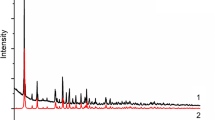Abstract
Li3InBr6 undergoes phase transition to a lithium superionic conductor at T tr = 314 K (σ = 5.0 × 10−4 S cm−1 at 330 K). The Rietveld analysis and the DSC measurement suggested that the positional disorder is introduced at the cationic sites above T tr. The X-ray powder diffraction pattern at the superionic phase changes gradually with temperature and finally shows a simple powder pattern at 420 K which is quite similar to that of LiBr. This rock salt structure contains intrinsic vacancies because one In3+ and two vacancies substitute for three Li+. 7Li and 115In NMR support the rapid diffusion of the Li+ and the introduction of the In3+ into the rock salt structure. On the other hand, the ionic conductivity for Na3InCl6 was 10−5 S cm−1 even at 500 K. Conduction path for the sodium ions could be proposed by means of the Rietveld analysis and the NMR experiment using a single crystal.
Similar content being viewed by others
References
Tomita, Y., Fujii, A., Ohki, H., Yamada, K. and Okuda, T., Chem. Lett. (1998), 223.
Tomita, Y., Yamada, K., Ohki, H. and Okuda, T., Z. Naturforsch. 53a (1998), 466.
Yamada, K., Iwaki, K., Okuda, T. and Tomita, Y. In: Chowdari, B. V. R., Prabaharan, S. R. S., Yahaya, M. and Talib, I. A. (eds.), Solid State Ionics: Trends in the New Millennium, World Scientific, Singapore, 2002, pp. 621–628.
Bohnsack, A., Stenzel, F., Zajonc, A., Balzer, G., Wickleder, M. S. and Meyer, G., Z. Anorg. Allg. Chem. 623 (1997), 1067.
Bohnsack, A., Balzer, G., Wickleder, M. S., Güdel, H.-U. and Meyer, G., Z. Anorg. Allg. Chem. 623 (1997), 1352.
Menetrier, M., Hojjaji, A., Estournes, C. and Levasseur, A., Solid State Ionics 48 (1991), 325.
Izumi, F. and Ikeda, T., Mat. Sci. Forum 321–324 (2000), 198.
Schmidt, M. O., Wickleder, M. S. and Meyer, G., Z. Anorg. Allg. Chem. 625 (1999), 539.
Yamada, K., Mohara, H., Kubo, T., Imanaka, T., Iwaki, K., Ohki, H. and Okuda, T., Z. Naturforsch. 57a (2002), 375–380.
Abragam, A., Principles of Nuclear Magnetism, Chap. VII, Oxford University Press, London, 1961.
Author information
Authors and Affiliations
Corresponding author
Rights and permissions
About this article
Cite this article
Okuda, T., Yamada, K. Structure and Ionic Conductivity of Halocomplexes of Main Group Metallic Elements Studied by NMR and NQR. Hyperfine Interact 159, 95–102 (2004). https://doi.org/10.1007/s10751-005-9198-9
Published:
Issue Date:
DOI: https://doi.org/10.1007/s10751-005-9198-9



